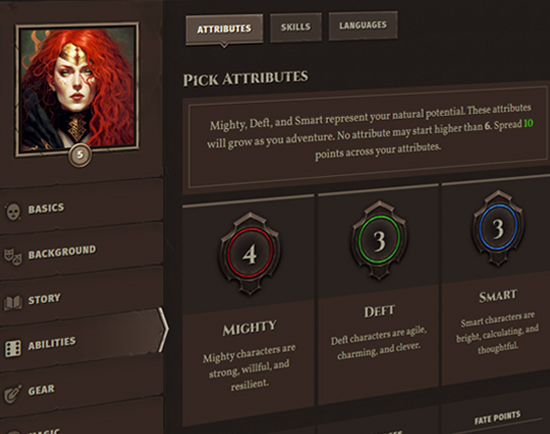Combat Encounters
When it's time for a fight, the cadence of the conversation becomes discrete, and action is handled on a turn-by-turn basis.
You roll for initiative, which determines the fastest you can act in the round. Then, you (and the GM) take turns acting, with ties resolved by your initiative. Once everyone has acted, we roll for initiative again to reset the turn order. This repeats until there is no longer a need to resolve the combat (the threat to the party is gone, or another game mode is invoked).
Rolling for Initiative
Each player rolls a d6. Add +2 if you have the skill Perception. The GM will roll separately for the enemies as a group (though he may create a separate initiative for special opponents like BBEGs or bosses). Each player and their opponents get to act once during the round. Generally, each turn is a few seconds long, and each round is one minute in duration.
Roll for initiative
Roll a d6 and add +2 if you have Perception, this determines your initiative in the round. The caller (or the GM) writes down everyone's initiative for reference later.
Start a Chain Reaction
Anyone can declare that they're acting, in any order. Let's say you rolled a 2. If you declare that you're taking your turn, the spotlight shifts to you, and a new chain reaction is started, representing a sequences of actions that are fictionally connected. Anyone with a higher initiative than 2 can react to you.
React with Priority
If no one with a higher initiative than you wants to intervene, then the GM resolves your action first, and the chain reaction is finished. Otherwise, the GM resolves the higher initiative player's action first, then the spotlight returns to you.
GM Resolution
After the GM resolves your action, the turn is over and the spotlight returns to the GM until someone else decides to start a chain.
You (and the GM) can take your turn in any order. When you declare you are taking your turn, the spotlight shifts to you and starts a chain.
If no one decides to start a chain reaction, then the player with the lowest initiative must take their turn next.
Simultaneous Initiative
If you roll the same initiative as another character and want to intervene against them, that means both of you resolve your action on that turn. The GM always moves the spotlight to PCs first (or may choose to spotlight any PC in any order if multiple PCs are involved), but all action is resolved simultaneously, meaning if you and your opponent both act on initiative order 3, and you are beheading your opponent while he's casting a spell, he will complete his spell, its effects will occur, and you will behead him at the same time.
Committing to Your Action
When you start a chain reaction, you're not committed to your action until the GM begins to resolve it. So if you start a chain and then someone else intervenes, taking the spotlight away from you, you can change your action when the spotlight returns to you. The point of no return is always when the dice are rolled, or when the GM begins narrating a resolution to your action.
Types of Actions
On your turn, you can move within a melee space and take one of the actions below. Your action can’t take longer than a few seconds to carry out, otherwise the GM may penalize you by lowering your initiative. Talking to other characters is not an action (and you may talk to anyone at any time during the round), so long as your conversation does not last longer than a few seconds.
Attack
You attempt to deliver harm or peril via your weapon or maleficence.
Cast
Use your magic in the form of a sorcery, psionic, or thaumaturgy spell.
Dodge
Spend your turn focusing on dodging attacks to improve your defense in the round. You confer disadvantage on any attacks made against you in the round.
Run
Move an encounter space (depending on the size of the scene) instead of a single melee space.
Use A stance
Some stances are actions unto themselves. The stance will always specify when it can be used in its description; if it does not, then it can be used as a bonus action on your turn in the round, or it happens at the same time as the action you take described in the stance.
Use with Finesse
You can use an item with finesse, such manipulate a magic item that requires activation; equip armor or shields; or read a scroll.
Reactions & Bonus Actions
In addition to your action, you make take as many bonus actions or reactions as are available to you from other abilities. The difference between a bonus action and a reaction is that a bonus action must happen on your turn, whereas you can take a reaction when you've been acted against.
Use your action to make an opposed attack roll with your weapon, shield, or maleficence to deflect an attack: if you succeed, their attack misses. (If you have more than one attack available to you in the round, such as via bonus actions, you can trade an attack for the option to parry at any time during the round.) You can also sacrifice your shield to parry an attack; this is called a shield sacrifice.
react
Act in response to someone else's action made against you (if you have an ability that allows you to do so, such as Counterspell or the kit ability Swashbuckler.) Reactions do not count as your action in the round unless the ability says so, and you can take as many reactions as you have available whenever the trigger that causes them happens. Reactions always have the highest initiative in the chain, and can only be interrupted by other reactions.
Use without Finesse
Most items in the game do not require finesse to use. Drinking a potion, picking up a weapon, or flipping a switch does not require finesse and therefore counts as a bonus action. Always confer with your GM when in doubt.
Switch Focus
At the start of the round, you may take a bonus action to slot a different stance into your focus for 1 MP.
Use A stance
Most stances function as reactions or bonus actions, but some stances are actions unto themselves. The stance will always specify when it can be used in its description; if it does not, then it can be used as a bonus action on your turn in the round, or it happens at the same time as the action you take described in the stance.
 Archetypes
Archetypes Armor
Armor Classes
Classes Conflicts
Conflicts Cultures
Cultures Ethos
Ethos Flaws
Flaws Glossary
Glossary Kits
Kits Maleficence
Maleficence Origins
Origins Shields
Shields Skills
Skills Spells
Spells Stances
Stances Status Effects
Status Effects Tactics
Tactics Talents
Talents Techniques
Techniques Treasure
Treasure Weapons
Weapons











 Hall of Heroes
Hall of Heroes Hall of Legends
Hall of Legends



 Dungeons & Flagons
Dungeons & Flagons